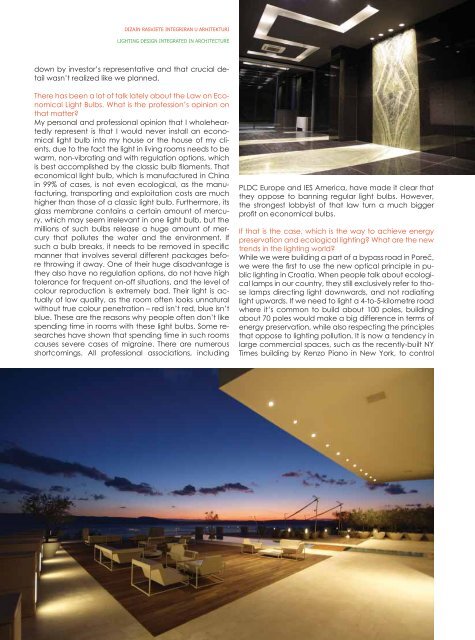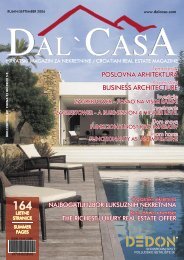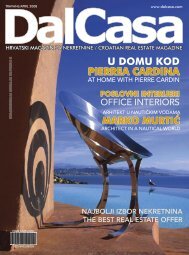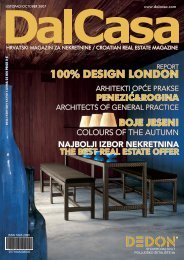DIZAJN RASVJETE INTEGRIRAN U ARHITEKTURILIGHTING DESIGN INTEGRATED IN ARCHITECTUREdown by investor’s representative and that crucial detailwasn’t realized like we planned.There has been a lot of talk lately about the Law on EconomicalLight Bulbs. What is the profession’s opinion onthat matter?My personal and professional opinion that I wholeheartedlyrepresent is that I would never install an economicallight bulb into my house or the house of my clients,due to the fact the light in living rooms needs to bewarm, non-vibrating and with regulation options, whichis best accomplished by the classic bulb fi laments. Thateconomical light bulb, which is manufactured in Chinain 99% of cases, is not even ecological, as the manufacturing,transporting and exploitation costs are muchhigher than those of a classic light bulb. Furthermore, itsglass membrane contains a certain amount of mercury,which may seem irrelevant in one light bulb, but themillions of such bulbs release a huge amount of mercurythat pollutes the water and the environment. Ifsuch a bulb breaks, it needs to be removed in specifi cmanner that involves several different packages beforethrowing it away. One of their huge disadvantage isthey also have no regulation options, do not have hightolerance for frequent on-off situations, and the level ofcolour reproduction is extremely bad. Their light is actuallyof low quality, as the room often looks unnaturalwithout true colour penetration – red isn’t red, blue isn’tblue. These are the reasons why people often don’t likespending time in rooms with these light bulbs. Some researcheshave shown that spending time in such roomscauses severe cases of migraine. There are numerousshortcomings. All professional associations, includingPLDC Europe and IES America, have made it clear thatthey oppose to banning regular light bulbs. However,the strongest lobbyist of that law turn a much biggerprofi t on economical bulbs.If that is the case, which is the way to achieve energypreservation and ecological lighting? What are the newtrends in the lighting world?While we were building a part of a bypass road in Poreč,we were the fi rst to use the new optical principle in publiclighting in Croatia. When people talk about ecologicallamps in our country, they still exclusively refer to thoselamps directing light downwards, and not radiatinglight upwards. If we need to light a 4-to-5-kilometre roadwhere it’s common to build about 100 poles, buildingabout 70 poles would make a big difference in terms ofenergy preservation, while also respecting the principlesthat oppose to lighting pollution. It is now a tendency inlarge commercial spaces, such as the recently-built NYTimes building by Renzo Piano in New York, to control52
and regulate artifi cial and natural light in a working facility.The latest technology allows this control to includelighting regulation with motorized outdoor shutters andmotorized indoor widow shades by Lutron’s Quantumand Eco systems that are from recently available in Europe.By measuring the light rays’ invasion angle, thisadvanced system regulates the moving of window shadesand the ignition of artifi cial light depending on thebuilding’s position towards the sun and the season ofthe year. Daylight harvesting has been put to maximumeffect. Europe will receive a new law in 2012, which willdetermine the minimum amount of light in all commercialobjects and have a direct effect on the way architectsproject facades in the future.dc INTERVIEWYou’ve also been very successful in designing lightingobjects. How did that idea come about?The idea to design a new lamp originated from a veryprecise demand that couldn’t be solved by any of theproducts on the market. I started to seriously think primarilyabout function, and the form simply came as a logicalextension. However, the form of that lamp wouldn’thave been possible three years ago, as the requiredtechnology wasn’t available at that time. That exampleclearly shows just how dependent this profession isto the development of technology. The series of lampsI’ve designed and that will be manufactured by iGuzzini,one of the world’s leading manufacturers of lightingobjects, and will be presented at the fair in 2011. Untilthen, the lamps will be used as special products onspecifi c objects. The form of this lamp is very convenientand adjustable, and can be used in numerous differentvariations in both interiors and exteriors, as well as generateinto different forms.How do you present your ideas? How do you suggestyour clients what they can expect when the job is fi -nished?My fi rst projects and the way we now project at TheHouse of Light always follow the same philosophy. Ourproject must be understandable to everyone, whichmeans that each participant can visualise the fi nal resultafter our presentations. We always make an effortto visually present the story, and that is followed by theall-important engineering part. It is absolutely crucial toensure that all participants in the process, from the investorsto people in charge of the realisation, receive allthe essential information from the get-go. And it is alsoimperative for the user to have a clear vision of what lightingsolution will look like before the installation is evenin the works. That’s why we frequently perform photosimulationsof interiors and exteriors and I must say thatI feel our simulations are about 80-90% accurate, as it isimpossible to create a 100% credibility because light is avery unpredictable phenomenon. Despite the fact thatlight is linear and its direction can be predicted, thereare numerous external factors that affect a facade, publiclighting or material refl exes etc. meaning it is very difficult to visualize everything prior to the realization process.That’s why our 80-percent precision actually goesa long way in serving our clients.ODABIR RASVJETNIH TIJELA U SKLADU JE S INTERIJEROMSELECTION OF LIGHTING FITTINGS IS IN ACCORD WITH INTERIORWhat is the projecting approach you represent in TheHouse of Light?We try to approach every project as if it is our only job,and we never compare it to any other assignment. Thereare no universal lighting solutions, but only rather similarexamples. The only limitation factors in our businessare existing technological sources of light and lamps. Inwich bulbs are situated. Bulbs possess a certain optic,narrow or wide beam, warm or cold light of a certainintensity, power, direction options, installation etc. Weare technologically limited, but there are no creativeboundaries, and that ends up as maybe the biggestproblem in our profession. When you’re going for a certaineffect, you always feel that the vision in your headcan be accomplished and permanently maintained,which is why it isn’t desirable to install lighting objects atinaccessible places – a facade is damaged if the bulbstops working and it can’t be replaced. It is importantto analyze all elements – the shape of the house, its locationand surrounding, which side is more accessibleand which points of view are crucial. As we simulate thelighting arrangement, we already know where to putcertain types of lamps, how to direct them and arrangeall other details, so there aren’t really any surprises.As our team consists of designers, electro-engineers andprogrammers, the product is a complete unit becauseof its creative value and because of maximum attentionto issues in technology, energy and management.All phases of our project include all necessary steps tomake these houses truly intelligent, and to make our clientsfeel comfortable and relaxed.53
















